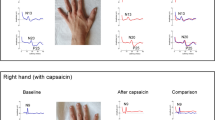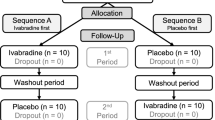Abstract
Only recently has a new experimental technique been developed which combines tonic and phasic painful stimulation. By means of this technique the non-steroidal anti-inflammatory drug (NSAID) ibuprofen has been shown to produce a dose-related decrease in heterotopically applied phasic and tonic pain. The present study aimed to investigate the dose-related pain. The present study aimed to investigate the dose-related effects of the NSAID ketoprofen (50, 100, and 150 mg i.v.) when tonic and phasic stimuli were applied homotopically. Eighteen healthy volunteers participated in the double-blind, randomized, placebo-controlled study. After an initial training session subjects took part in four experiments, each of which was divided into three sessions (before, 30, and 120 min after drug administration). During each session 45 painful phasic CO2 stimuli of three concentrations were presented to the left nostril in randomized order (duration 200 ms; interval 40 s; 45%, 52%, and 59% v/v CO2). The left nostril was additionally stimulated with a constant stream of dry air, which produced a tonic painful sensation described as dull and burning. Subjects rated the intensity of the painful stimuli by means of visual analogue scales. Chemosomatosensory event-related potentials (CSSERPs) were recorded in response to phasic painful CO2 stimuli. Ketoprofen reduced the subjects' estimates of tonic pain in a dose-related manner. In contrast, given the special conditions of homotopic application of tonic and phasic painful stimuli, estimates of phasic pain increased significantly, corresponding to a significant increase in CSSERP amplitudes. An explanation of this inverse effect of the drug on responses to tonic and phasic pain may be a lateralized interaction between both C-fiber and Aδ-fiber systems at a spinal or peripheral level.
Similar content being viewed by others
References
Hill HF, Chapman CR, Saeger LS, Bjurstrom R, Walter MH, Schoene RB, Kippes M (1990) Steady-state infusions of opioids in human. II. Concentration-effect relationships and therapeutic margins. Pain 43:69–79
Arendt-Nielsen L (1990) First pain event related potentials to argon laser stimuli: recording and quantification. J Neurol Neurosurg Psychiatry 53:398–404
Bromm B, Ganzel R, Herrmann WM, Meier W, Scharein E (1987) The analgesic activity of flupirtine in comparison to pentazocine and placebo assessed by EEG and subjective pain ratings. Postgrad Med J 63 [Suppl 3]:109–112
Kobal G, Hummel C, Nürnberg B, Brune K (1990) Effects of pentazocine and acetylsalicyclic acid on pain-rating, pain-related evoked potentials and vigilance in relationship to pharmacokinetic parameters. Agents Actions 29:342–359
Handwerker HO, Kobal G (1993) Psychophysiology of experimentally induced pain. Physiol Rev 73:639–671
Beecher HK (1953) Limiting factors in experimental pain. J Chron Dis 4:11–26
Gracely RH (1989) Methods of testing pain mechanisms in normal man. In: Wall PD, Melzack R (eds) Textbook of pain. Livingstone, Edinburgh, pp 257–268
Smith GM, Egbert LD, Markowitz RA, Mosteller F, Beecher HK (1966) An experimental pain method sensitive to morphine in man: the submaximum effort tourniquet technique. J Pharmacol Exp Ther 154:324–332
Forster C, Anton F, Reeh PW, Weber E, Handwerker HO (1988) Measurement of the analgesic effects of aspirin with a new experimental algesimetric procedure. Pain 32:215–222
Magerl W, Geldner G, Handwerker HO (1990) Pain and vascular reflexes in man elicited by prolonged noxious mechano-stimulation. Pain 43:219–225
Jones SF, McQuay HJ, Moore RA, Hand CW (1988) Morphine and ibuprofen compared using the cold pressor test. Pain 34:117–122
Chen ACN, Dworkin SF, Haug J, Gehrig J (1989) Human pain responsitivity in a tonic pain model: psychological determinants. Pain 37:143–160
Forster C, Magerl W, Beck A, Geisslinger G, Gall T, Brune K, Handwerker HO (1992) Differential effects of dipyrone, ibuprofen, and paracetamol on experimentally induced pain in man. Agents Actions 35:112–121
Kobal G, Hummel C, Gruber M, Geisslinger G, Hummel T (1994) Dose-related effects of ibuprofen on pain-related potentials. Br J Clin Pharmacol 37:445–452
Thürauf N, Friedel I, Hummel C, Kobal G (1991) The mucosal potential elicited by noxious chemical stimuli: is it a peripheral nociceptive event. Neurosci Lett 128:297–300
Steen KH, Reeh PW, Anton F, Handwerker HO (1992) Protons selectively induce lasting excitation and sensitization to mechanical stimulation of nociceptors in rat skin, in vitro. J Neurosci 12:86–95
Kobal G, Hummel T, Hoesl M (1989) Pain-related electrical evoked potentials by chemical stimuli: effects of fentanyl. In: Lipton S, Tunks E, Zoppi M (eds) Advances in pain research and therapy, vol 12. Raven Press, New York, pp 95–98
Hummel T, Friedman T, Pauli E, Niebch G, Borbe HO, Kobal G (1991) Dose-related analgesic effects of flupirtine. Br J Clin Pharmacol 32: 69–76
Hummel T, Hummel C, Friedel I, Kobal G (1994) Assessment of antinociceptive effects in man: comparison of imipramine, tramadol, and anpirtoline. Br J Clin Pharmacol 37:325–333
Kobal G, Huber H, Pauli E, Hummel T (1990) Testing the analgesic activity of dipyrone in human subjects using an experimental pain model with tonic and phasic pain stimuli. In: Brune K (ed) New Pharmacological and epidemiological data in analgesics research. Birkhäuser, Basel, pp 27–37
Ejstrup L, Knudsen JV, Petersen L (1988) A randomized double-blind multicenter trial comparing tenoxicam and ketoprofen in osteoarthritis. Curr Ther Res 44:528–534
Kantor T, Cavaliere MB, Hopper M, Roepke S (1984) A double-blind parallel comparison of ketoprofen, codeine, and placebo in patients with moderate to severe postpartum pain. J Clin Pharmacol 24:228–234
Nuki G (1990) Pain control and the use of non-steroidal analgesic anti-inflammatory drugs. Br Med Bull 46:262–278
Veys EM (1991) 20 years' experience with ketoprofen. Scan J Rheumatol 90 [Suppl]:3–44
Kobal G, Hummel T (1991) Olfactory evoked potentials in humans. In: Getchell TV, Doty RL, Bartoshuk LM, Snow Jr JB (eds) Smell and taste in health and disease. Raven Press, New York, pp 255–275
Kobal G (1985) Pain-related electrical potentials of the human nasal mucosa elicited by chemical stimulation. Pain 22:151–163
Becker DE, Yingling CD, Fein G (1993) Identification of pain, intensity and P300 components in the pain evoked potential. Electroencephalogr Clin Neurophysiol 88:290–301
Picton TW, Hillyard SA (1988) Endogenous event-related potentials. In: Picton TW (ed) EEG Handbook, vol 3, revised series. Elsevier, Amsterdam, pp 361–426
Upton RA, Buskin JN, Guentert TW, Williams RL, Riegelman S (1980) Convenient and sensitive high-performance liquid chromatrography assay for ketoprofen, naproxen and other allied drugs in plasma or urine. J Chromatogr 190:119–128
Duncker K (1936) Some preliminary experiments on the mutual influence of pains. Psychol Forsch 21:311–326
Chen ACN, Treede RD, Bromm B (1984) Modulation of pain evoked cerebral potential by concurrent subacute pain. In: Bromm B (ed) Pain measurement in man. Neurophysiological correlates of pain. Elsevier, Amsterdam, pp 301–310
Ley SJ, Livingston A, Waterman AE (1989) The effect of chronic clinical pain on thermal and mechanical thresholds in sheep. Pain 39:353–357
Le Bars D, Dickenson AH, Besson JM (1979) Diffuse noxious inhibitory control (DNIC). I. Effects on dorsal horn convergent neurones in the rat. Pain 6:283–304
Willer JC, De Broucker T, Le Bars D (1989) Encoding of nociceptive thermal stimuli by diffuse noxious inhibitory controls in humans. J Neurophysiol 62: 1028–1038
Bing Z, Villanueva L, Le Bars D (1990) Acupuncutre and diffuse noxious inhibitory controls: naloxone-reversible depression of activities of trigeminal convergent neurons. Neuroscience 37:809–818
Mackenzie RA, Burke D, Skuse NF, Lethlean AK (1975) Fiber function and perception during cutaneous nerve block. J Neurol Neurosurg Psychiatry 38:865–873
Torebjörk HE, Hallin RG (1971) Perceptual changes accompanying controlled preferential blocking of A and C fibre responses in intact human skin nerves. Exp Brain Res 16:321–332
Hummel T, Gruber M, Pauli E, Kobal G (1994) Event-related potentials in response to repetitive painful stimulation. Electroencephalogr Clin Neurophysiol 92:426–432
Malmberg AB, Yaksh TL (1992) Hyperalgesia mediated by spinal glutamate or substance P receptor blocked by spinal cyclooxygenase inhibition. Science 257:1276–1279
Thürauf N, Hummel T, Kettenmann B, Kobal G (1993) Nociceptive and reflexive responses recorded from the human nasal mucosa. Brain Res 629:293–299
Author information
Authors and Affiliations
Rights and permissions
About this article
Cite this article
Hummel, T., Menzel, S., Kobal, G. et al. Tonic versus phasic pain: dose-related effects of ketoprofen. Eur J Clin Pharmacol 49, 7–14 (1995). https://doi.org/10.1007/BF00192351
Received:
Accepted:
Issue Date:
DOI: https://doi.org/10.1007/BF00192351




